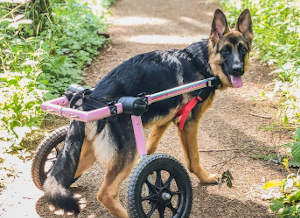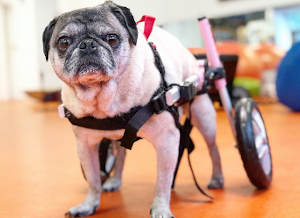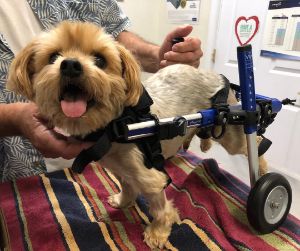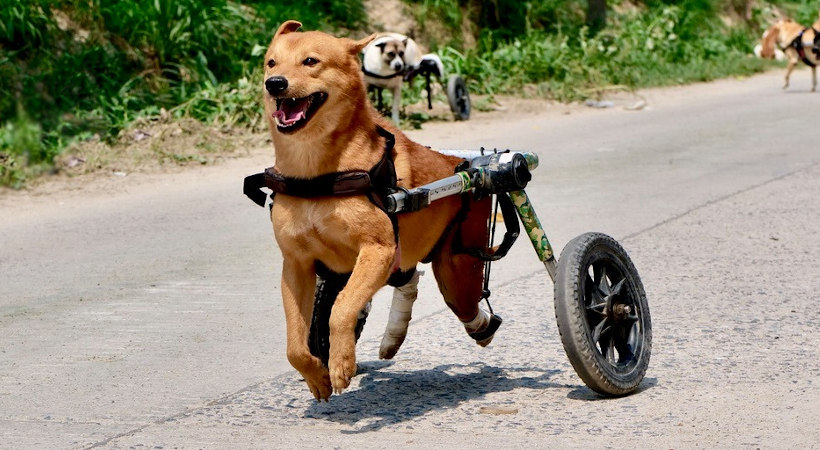Article written by Dr. Claire Porter, DVM
What Knee Injuries Can a Dog Have?

When your furry best friend is in pain, you will do whatever you can to ease their discomfort and quickly get them on the mend. Knee injuries in dogs cause a great deal of discomfort. Especially if the injury is related to a tear in the anterior cruciate ligament (ACL) or the cranial cruciate ligament (CCL). These ligaments maintain stability in your dog’s upper tibia and lower femur and they are cushioned by cartilage called medial and lateral menisci. When a partial or complete tear occurs in one of these ligaments, it’s not only painful, but it also risks further damage to the surrounding cartilage and bone if left unaddressed.
Because dogs walk with knee joints in their back legs that are always flexed, these ligaments are regularly under tension. Over many months or years, this constant tension can cause degeneration within the ligaments, which could increase the risk of ACL and CCL tears as your dog ages.
5 Signs Your Dog Has a Knee Injury
Cruciate ligament injuries are the second most common orthopedic condition found in dogs after hip dysplasia, and they are the most frequent condition that requires operation or surgical efforts to encourage healing. There are several signs that your dog has suffered a painful knee injury, including:

1. Inability to Play, Run, or Jump
In the case of an ACL or CCL tear, this will most likely come on with little warning after the tear occurs. If your dog is suffering from a knee injury, they will take great care not to put any weight on the injured leg, and it will be obvious that they are in pain. Although less critical than a cruciate tear, dogs with a luxating patella often run with their back leg pointed behind them until their knee cap pops back into position.
2. Sitting Strangely
If you notice that your dog has begun to sit abnormally, typically sticking their leg out to the side rather than tucking it in, this is most likely due to a knee injury.
3. Swelling in the Knee
CCL injuries cause inflammation and swelling, and they will develop scar tissue over time. This makes the injured knee appear larger than the others.
4. Stiffness in Hind Legs
Roughly 60% of dogs that have a CCL injury will get one in their other knee within two years. If both knees are affected, your dog may appear to have stiffness upon rising and moving around.
5. Clicking
When your dog has an injured knee, it puts strain on the other legs. A shock-absorbing patch of cartilage called the meniscus can easily become damaged, causing severe discomfort and often accompanied by a clicking sound.
Treatment for ACL & CCL Injuries in Dogs

While surgery is often required to heal a torn ligament, it is possible for dogs to recover through alternative methods.
However, determining whether or not your pet can completely heal without surgery is best left to the experts and depends heavily on the specifics of your dog’s injury. Some common treatments for ACL and CCL injuries are:
Orthopedic Brace:
Many dog owners opt for an orthopedic brace as an alternative to surgery. These braces are flexible and feature a joint that allows for natural movement. A knee brace helps stabilize the tarsal joint throughout the healing process.
Acupuncture:
This is one of the oldest forms of alternative treatment for humans; however, most pet owners don’t realize that it can also be an effective method of treatment for their pets.
Supplements:
Giving your dog supplements such as fish oil, turmeric, and glucosamine can have great long-term effects on their joint and overall health.
Swimming:
The physical benefits of hydrotherapy are incredibly for dogs with knee injuries. This is a perfect, low-impact form of treatment that will allow your dog to work his or her muscles comfortably. Just make sure you don’t overdo it.
Massage:
Providing your pup with a massage catered to their specific injury encourages self-healing and eases the debilitating pain associated with canine knee injuries.
Orthopedic Surgery
When alternative methods of treatment simply won’t provide the healing your dog needs, there are three main orthopedic procedures available to repair a torn ACL or CCL:
EXTRACAPSULAR LATERAL SUTURE STABILIZATION (ELSS)
ELSS surgery works by counteracting the tibial thrust with a specifically placed suture. Prior to tearing, the ligaments had served the purpose of countering the forward “thrust” of the knee. ELSS will now replicate that opposing force by “anchoring” the tibia to the femur.
TIBIAL PLATEAU LEVELING OSTEOTOMY (TPLO)
TPLO has become one of the most popular surgeries for ACL tears in dogs. It works by altering the dynamic of the knee by changing the angle of the tibial plateau. To achieve the correct angle, the bone is cut and the tibial plateau is rotated where the femur and tibia meet. This prevents the femur from sliding backwards. The most impressive thing about TPLO is the recovery time. Because the stabilization is immediate, most dogs are weight-bearing immediately following surgery.
TIBIAL TUBEROSITY ADVANCEMENT (TTA)

TTA is similar to TPLO in that the surgery is not aimed at repairing the torn ligament, but rather changing the dynamics of the knee altogether so that the ligament is no longer needed.
In TPLO surgery, a linear cut is made along the front of the tibia. Then the bone is moved forward, and a specialized spacer is inserted between the tibia and the tuberosity (the front part of the tibia). Finally, a steel plate is applied to stabilize your dog’s bone.
While surgery is ultimately the most expensive option, most vets provide financing. Helping to ease the burden of cost while ensuring your dog gets the attention they need.
Make the Right Decision for Your Pet
Several factors come into play when choosing the most appropriate treatment method for your dog’s ACL or CCL injury. These include: the severity of the tear, your dog’s age, and their overall health.
Your veterinarian will be able to provide you with the most comprehensive options available for your dog’s unique needs, while also keeping in mind your pet’s health history and any hereditary issues that could affect the healing process. With your help and the expert advice of your veterinarian, it’s wholly possible to get your best friend feeling better and back to their old self again!
Guest Author:
Dr. Claire Porter, DVM
Dr. Porter is a veterinarian at Village Vet of Urbana in Ijamsville, MD
